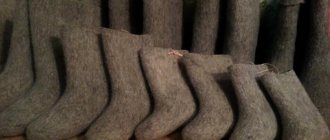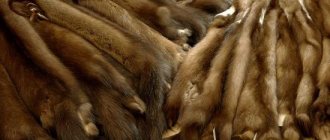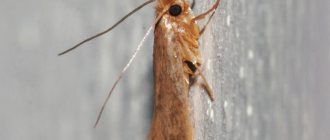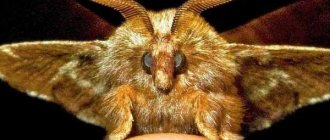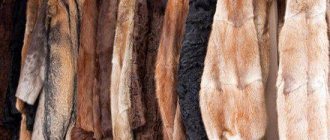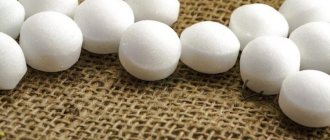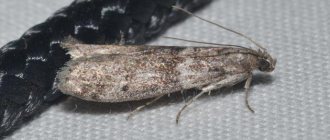A fur coat is the warmest and most expensive item in any wardrobe. Clothing made from luxurious fur is bought for more than one year, so it is so important that it retains its appearance for a long time.
The main problem that owners of such things may encounter is moths, or rather, their larvae that are deposited. What does a mink coat look like that has been eaten by larvae, and how to get rid of it and protect yourself with moth repellents, you will find useful recommendations from specialists.
When infested by pests, characteristic bald patches appear. Using effective products and proper storage methods will help get rid of harmful butterflies and prevent their appearance.
How to tell if a moth has eaten your fur coat
Food butterflies and other species often appear in the apartment. Clothes or fur coat varieties are harmful. To take the necessary measures, it is important to know what a fur coat moth looks like. It looks like a light and colorless individual of small size. It is difficult to identify and recognize, it is practically invisible, and is located deep in the pile, in a deep bag. After it, bald spots appear.
Butterflies may vary slightly in size and color, but caterpillars are similar to each other. You can see what a fur coat damaged by moths looks like in the photo.
The main enemy is moth larvae
So, a moth has eaten your fur coat and your favorite, and expensive, wardrobe item is irretrievably lost, but the pest must be destroyed in any case. First of all, disinfection is carried out, aimed at eliminating moth larvae, which are most likely hidden from the human eye among the fibers. The fact is that in search of a new source of food, they can spread to other woolen items - moth larvae (caterpillars) feed on wool fibers in any form. Moreover, the insect eats only the hair, leaving the skin untouched.
The domestic pest at this stage of development is inactive and can always be found at the base of the fur hairs. Here, for their own comfort, the larvae weave small silk covers, which are changed after each molt. This is how the fur coat moth fundamentally differs from carpet beetles (they also appear in the house and spoil natural products - fur, leather), the larvae of which feed on both hairs and the leather part.
Fur coat moth larva in a cocoon - it is she who makes bald spots on a fur coat
Fur coat damaged by moths
Adults hide in the folds of a mink or mouton coat and piles of things, where they prepare for reproduction.
In inconspicuous corners, harmful butterflies lay eggs, from which caterpillars emerge. The fast-growing caterpillars begin to eat textiles and leave marks.
The presence of moths is indicated by the following signs:
- It looks like it’s not combed, but rather ragged. The fibers stick out in different directions, and the surface looks sloppy.
- There are hairs in the places where the headset is placed after moths have started to appear and the caterpillars have begun to eat the lint.
- Tracks appear on the surface as the caterpillars move.
What do adults eat?
Having figured out how the larva eats, the question arises of what an individual adult moth eats. Despite the widespread belief that it is harmful, the butterfly is not capable of damaging food and things, since it does not have a developed feeding apparatus.
The most significant damage occurs in egg laying. It turns out that only moth larvae eat, and adult moths contribute to the reproduction of offspring.
Underdevelopment of the proboscis and intestines at the butterfly stage reduces the lifespan of the insect to 15-30 days. An adult moth is able to feed on the reserve fat accumulated during the caterpillar stage, and at the end of it, on its own muscles, thereby shortening its lifespan.
It is because of this that at the end of life the mass of the parasite is 2 times less. If the female carries eggs, then the duration of existence does not exceed 14 days. At the same time, males are able to live up to 1 month.
Where do larvae come from?
The main sign of pests is flying through the cabinets and throughout the apartment. Defects can only be detected when worn, when tears can form in damaged areas and fabrics can unravel.
Before purchasing, a fur coat should be examined for the presence of fine traces of lint. When you arrive home, you need to hang your purchase on the balcony. Ventilate items only in warm weather. It could be a warm sunny day or even a winter frost.
The sun and air drive out possible insects.
Many people are interested in where moths come from? Items brought into the house must be inspected for the presence of parasites. The insect enters the house already on objects purchased in stores, in the form of invisible larvae, or even on the fur of dogs or cats. Pests that get into the house begin to eat fabric and other objects.
Life cycle features
Moths in fur coats appear in the summer when the product is hidden in a closet for storage. In winter, the insect can also be in the house, but due to the fact that the fur product is often worn and periodically “walked” in the cold, the larvae die from the low temperature. In summer, all conditions are created for the normal existence of the insect.
On a note!
For fur coat moths, little is required - no direct sunlight, a temperature of at least +10 degrees Celsius, moderate humidity, and a fur coat in the closet.
Most often, moths enter an apartment or house through open windows in the evening. The butterfly becomes active at night and quickly flies towards the light. Once in a person’s house, he looks around and determines by smell the presence of a fur coat or other fur products in the closet.
The butterfly itself does not feed on anything and lives for about 14 days. But during this time it lays about a hundred eggs. The larvae are born within a few days and develop for about a month. All this time they are actively sharpening their fur coat. In a month, even one caterpillar causes significant damage. If there are several caterpillars, by the beginning of winter the fur coat will become unwearable.
Effective means
There are many chemicals and folk methods on how to preserve mink fur and get rid of moths.
Case
You can use the raptor case. The sealed clasp will protect against pests getting inside. In this case, insects that get inside die. The special composition does not harm objects and does not impregnate them with foreign odors. Similar raptor products can be seen in the photo.
Aerosol
Do not spray the product directly onto the surface. This can ruin the fur. In this case, the entire cabinet is treated against moths. One can will be required for the entire season. The procedure is carried out twice a month.
Since the products contain insecticidal components that are harmful to humans, a mask, respirator and gloves are worn.
Children and animals should be removed from the room, as fumes can cause poisoning. After processing, the cabinets are tightly closed.
Such drugs as raptor, aerosol raid, extra mit are distinguished by their effectiveness.
Pills
Such products are produced in special boxes. They are highly concentrated and the smell remains for a long time. The effect of the drug lasts for several months.
The tablet not only destroys moths, but also prevents them from multiplying in the closet and protects against the appearance of eggs. Sections also work. The records are hung inside the furniture, as can be seen in the photo.
Useful tips
Of course, moths do not appear out of thin air.
Butterflies can fly into the house through a window, front door, through cracks or vents. Pests can also be brought in by the residents themselves - in food or belongings. To prevent the appearance of moths in the house, you need to install mosquito nets on windows and vents. Bulk products must be stored in airtight containers or tightly closed jars, then pests will not be able to penetrate the cereals. Unfortunately, it often happens that moths are already in purchased cereals, tea or dried fruits. After purchasing food in a store or market, you should inspect or sort through it to make sure there are no moths.
If there are moths in the house, or the room has recently been treated for moths, it is better not to stock up on food for future use. Butterflies can also be found in salt, which insects do not feed on, but thrive in it.
It is best to store seasonal clothing in vacuum bags. Items must be washed and ironed. You can buy special covers for fur or leather outerwear. Several times during the warm season you need to check the safety of a fur coat or jacket by shaking it. If there are eggs or caterpillars on the item, they will fall out immediately.
For prevention, it is better to periodically dry and ventilate fur products. Moths will never want to live in clean clothes. These insects will only be interested in clothes that have already been worn. If the item is not going to be worn for a long time, then you definitely need to wash it or dry clean it - and only then put it in the closet.
Adult butterflies, unlike larvae, cannot eat, but they can drink. Water prolongs the life of an adult, which means that they will reproduce successfully. If a faucet or pipe is leaking in the kitchen, you need to fix the problem. It is also a good idea to keep your kitchen sink dry and clean.
Carpets are a favorite place for moths. To prevent the appearance of these insects, carpets should be vacuumed regularly, even if they are not in use and are stored rolled up. Moths do not like cleanliness, so you should always clean your house or apartment thoroughly. For prevention, you can regularly add a little vinegar, turpentine or a couple of drops of essential oil to the water when washing floors.
A few weeks after treating the room against moths, it is necessary to re-inspect the entire house, and with special attention check those places where larvae and egg laying were located. It is likely that some area was missed and re-treatment is necessary.
You should not neglect the advice for preventing the appearance of these insects, because moths start up very quickly, and it is not always possible to notice it in time, and removing the insects is very difficult. It is always easier to prevent the appearance of moths than to spend enormous efforts fighting them later.
To learn how to get rid of moths simply and forever, watch the following video.
Folk recipes
Simple and natural methods of insect control are highly effective as preventative measures that can protect and protect against moths. Naphthalene doesn't help much. Folk remedies scare away butterflies with their aroma; you can make special plates with your own hands.
You can place essential oils, orange peels, scented soaps, ammonia and herbal infusions in the closet.
Combined control methods that allow you to get rid of pests are characterized by effectiveness.
Appearance of fur and clothes moths
Before you start fighting a pest, you need to identify it.
It’s not for nothing that we talk about two types of moths. They are both capable of ruining a mink coat because they feed on wool and fur. Both the clothes moth and the fur moth are small butterflies. The length of the body is 7-8 mm. It is impossible to distinguish a clothes moth from a fur moth with the naked eye. They both have an unsightly gray color. The only difference is in its intensity. The clothes moth is literally half a tone lighter than the fur moth. The shape of the wings and the length of the fringe that surrounds them are slightly different. But these differences can only be seen under a microscope or on an enlarged photo of the pest.
The larvae live at the base of the fur, so detecting them is problematic. Insects move slowly. When moving, they don’t just crawl through the fur, but cut their way. As a result, passages remain on the mink coat, which are visible to the naked eye.
First, you need to determine the extent of damage to clothing and who is the main enemy at this stage: butterflies or larvae. If the moth has become thoroughly established in the mink coat, then the clothes and closet should be treated with insecticides. There is a wide variety of products on the market today designed to combat parasites.
Within 2-3 hours after using the insecticide, adults, larvae and eggs will die. But before using the product, read the instructions for use. If things are handled incorrectly, not all individuals will die. And the remaining parasites will quickly restore the population and develop a defense mechanism to the previously used drug.
The following drugs have proven themselves on the market:
- Raptor Moth Protection;
- Antimol;
- Clean house;
- Extramit;
- Armol.
These are aerosols. They are used to treat clothes that have been eaten by moths. After processing, items are placed in clothing covers or plastic bags and left for 48 hours. It is advisable to pre-treat the covers as well. Moth repellent for fur coats does not damage the fur of the product. They directly kill parasites.
To kill moths, you can use products that are designed to fight other insects. The effects of insecticides on all insects are approximately the same. But, when removing fur or clothes moths, you should remember that things will have to be processed. Therefore, you need to use those aerosols that are odorless and do not leave marks on clothes. Otherwise, after processing the item will have to be thrown away.
We suggest you read: How to determine opisthorchiasis in fish
The second group of products that are commercially available are fumigators. They are not recommended to be used to combat this pest. Fumigators are effective, but act slowly. In our case, we need a product that will instantly destroy insects.
What to do if you can’t get rid of harmful butterflies on your own? In this case, it is advisable to contact specialists who will help solve the problem. You can take things to the dry cleaner or sanitary and epidemiological station. While specialists will fight the insects that are on things, you need to treat the surface of the cabinet, especially hard-to-reach places.
The next group of products are tablets and sections. They are cheaper than insecticides. But do not delude yourself about the effectiveness of such means. It is advisable to use them to prevent the appearance of unexpected guests in the closet, and not to fight them. After the expiration date, these drugs must be replaced with new ones.
Our ancestors knew how to protect a fur coat from moths. True, as practice shows, traditional methods of combating fur moths are less effective than chemical ones.
The insect is afraid of high temperatures. Therefore, on a hot day, place the contaminated clothing inside the car and expose the vehicle to the sun. But, this method can only be used in summer. With this treatment, some larvae or adults may survive. Therefore, before putting things back into the closet, you need to carefully inspect them for the presence of surviving parasites.
The harmful insect does not like odors:
- tobacco;
- dried orange or tangerine peels;
- lavender;
- strawberry soap;
- geraniums;
- daisies.
But these folk remedies are more suitable for preventing fur moths than for combating them, since they only repel adult individuals. The larvae are insensitive to strong aromas. Another smell that insects cannot tolerate is the smell of mothballs. However, this very unpleasant aroma is absorbed into things and will follow you everywhere.
Summer storage
In winter, the item is worn every day and is not threatened by dangerous residents. Here's how to protect a mink coat from moths in the summer so that the fur is not destroyed by pests. Moreover, even in summer, it can be well preserved at home if you know the rules.
Before storing outfits, they should be cleaned. The cabinet is then thoroughly washed and sprayed. Repellent drugs are placed inside.
After this, the product can be placed in a bag or in a special case. It is better to prepare a separate storage space.
The following actions are carried out with a mouton or mink coat:
- Ventilate.
- After a few days, it should be combed with a special brush.
- Buttons and hooks are fastened, and all sweets are straightened.
For storage, it is necessary to choose places that are located far away from heating equipment. The humidity in the room should not be higher than 65%.
The product is packaged in dark covers or fabric bags. You can use cellophane packaging. Hangers need to be selected according to size.
Things must be periodically removed from the case and allowed to breathe, which will help protect them from insects.
War for fur products
When larvae of the “fur” parasite are detected in a fur coat, not a minute can be lost. Moths absorb fibers very quickly, so if you decide to take action tomorrow, you risk losing a few more square centimeters of warm product.
So, let's figure out how to remove moths from a fur coat. First, you need to immediately comb it with a fine-toothed comb. This way you can remove parasite eggs and some of the larvae that destroy your favorite item. It is necessary to carry out the procedure over a bathtub, so that at the end of the “session” you can wash off the uninvited guests with boiling water and prevent re-infection of the apartment.
Secondly, the affected item should be taken outside. The ideal option in the fight for a fur coat would be severe frost or, conversely, severe heat outside the window. Moth larvae hidden in seams and folds will not be able to develop at critical temperatures and will soon die. “Thermal baths” are usually arranged for 2-3 days.
Oddly enough, especially “lucky” insects can survive even after such a severe test. You can finish them off with special anti-parasite aerosols, which are sold in household chemical stores. It is better to check with your sales consultant which product to choose and how to treat a mink coat or other fur product against moths.
The final step in expelling moths will be the use of a proven folk remedy. You can put dry mint leaves, lavender or orange peels in the pockets of the “cured” item. A moth will not even approach a cannon shot of such a “complete” product.
Regular tobacco can also protect a fur coat from insects. Just sprinkle it on the bottom of the closet. The specific smell will repel moths.
Regular tobacco can rid you of moths and their larvae and save your fur coat
Knowing what to do if moths start eating your fur coat, you can easily defeat the unpleasant parasite.
What to do with a fur coat eaten by moths
It is very disappointing if the fur coat is slightly damaged by moths or its edges are frayed. But even in such cases, clothes can be saved if you know how to restore the product. For example, take it to the dry cleaner.
You can update the product and give it shine at home. For this, flour, talc or starch is used. The item to be treated should be laid out on a horizontal surface and sprinkled with the selected product. Then you need to rub the pile. After dry cleaning, you just need to shake the item.
How to restore clothes?
First of all, you need to do a good cleaning. A special product is purchased for the procedure. In the fresh air, the fur coat should be treated, and then the clothes should be cleaned with a brush. In this case, you can get rid of moth larvae. It is important to remove matted fur, as larvae breed in it.
You need to clean a fur coat with a light color that looks yellowish. For this you will need mild shampoos and brushes. After wet processing, it is dried, and then the dry pile is combed with a brush.
Methods for restoring a fur coat
Even if a butterfly has eaten a fur coat, this does not mean that the clothes should be thrown away. It all depends on the degree of damage. If you took action in time and destroyed the pest, you can correct the fur coat and continue to wear it.
If the affected areas are small in size and hidden from prying eyes, then you can paint over the bald spots. To do this, you will need a felt-tip pen in the color of your fur with a thin tip.
The gap can be decorated with embroidery or a patch. In addition, combining fur products with other fabrics is now in fashion.
A brooch or stole will help hide your bald spot. But this is the case if problem areas have formed near the collar.
Another good way is to cut out the affected area. To do this, you need to carefully cut it and sew up this place. When sewing, do not tighten the thread too much, otherwise the fur will shrink and you will get an uneven seam. Before you start cutting, make sure that the seam will not be visible. If you are far from masterful with a needle, it is better to take your outerwear to a tailor.
If the insect did not leave you a chance for restoration, another option is possible. Fur coats that have been eaten by moths can be altered, for example:
- combine with other fur;
- shorten;
- turn into a vest;
- sew a fur hat.
Do not despair if a moth has eaten a mink coat or other woolen clothing, because you can always correct the situation. But from now on, be careful and take preventive measures.
For prevention
Why do moths eat fur coats? Because for her it is the best source of nutrients. The fur product attracts insects with its smell, which they pick up from a great distance. A “pleasant addition” for pests will be the presence of contaminants on the surface and inside of fur or wool clothing. Worn sleeves and collars with traces of human sweat and sebum will be a kind of beacon for moths.
In order for your favorite thing not to turn into a “table and home”, it must:
- regularly ventilate and shake;
- store in an individual case on a shelf or compartment separate from other things;
- dry well before sending for summer storage;
- carry out seasonal cleaning in the studio before and after winter;
- when storing, turn it inside out and wrap it in newsprint (pests don’t like its smell);
- treat with repellent insecticides.
Simple rules for using and storing fur items will protect them from damage by harmful insects. Saving a fur coat or fur vest is much more difficult than promptly cleaning the fur from existing contaminants and purchasing a special cover.
Useful video for the prevention of fur moths
The fur moth is a small, shiny clay yellow moth. The wingspan is only 15 mm. The color is inconspicuous, the wings are fringed, and dark spots are visible on the front wings. The larvae are smooth white caterpillars with a dark head. They live in a portable case and gnaw fur, regardless of whether they eat it or not. Fur moths are also called house moths. This is the most unwanted pest, the damage from which amounts to thousands. The caterpillar attacks mainly furs.
Moth traces found
If it has already become noticeable that a moth is eating a fur coat, then immediately chemically treat the product so as not to spread the moth infestation to other areas. Follow these steps:
- Carefully examine the fur, remove matted lumps (they contain moth larvae). Apply moth repellent to the entire area of the product, then shake and hang to air;
- When a moth has eaten a fur coat in a small area in the collar or chest area, it will be appropriate to hide the unsightly spot with a large brooch, drapery, scarf or stole;
- If the fur coat has not been eaten by moths so much and from the outside it will not be so noticeable, the slightly bald areas of the outerwear can be painted over with a felt-tip pen to match the fur. At some distance, a bald spot will not give itself away;
- With skillful use of a needle, you can use this method of hiding bald spots. Using a blade, carefully cut out a piece of leather in the moth-stricken area and stitch down the edges. Such a seam will not be noticeable under the fur at all if it is done correctly and the fur coat does not lose its charm;
- The most radical way to revive a fur product is to alter it in a new way, removing damaged areas and replacing it with other materials. You can, for example, create a new short fur coat using two types of fur, or combine it with knitted or guipure fabric inserts, as in the photo.
We suggest you read: Cat itches from flea collar
Folk remedies for potato moth
There are a number of popular techniques that will help reduce the number of pests in the garden. For example, caterpillars will not feed on tubers if a little ash is thrown into the holes when planting. There are also recipes for spraying plants during the summer (2-3 times per season):
- Combine a glass of wormwood herb and the same amount of ash, pour 3 liters of boiling water, leave for 2 hours.
- Mix 100 g of grated laundry soap, 200 g of wormwood and 50 g of onion peels. Brew 5 liters of boiling water and leave for 3 hours.
- Boil a kilogram of celandine stems for 10 minutes in 5 liters of water, let cool. Dilute the product with 5 liters of water before use.
A few more tips:
Now you know which plant repels moths with its smell. Finally, remember a few important rules:
- Anti-moth plants should be used immediately, avoiding severe infestation of the room with butterflies;
- Change the products periodically - once the insect gets used to one scent, it will stop reacting to it. Remember, dry herbs retain their fragrant properties for 2-3 months;
- For an enhanced attack, use a whole collection of aromatic plants.
Where do moths come from in an apartment and how to get rid of them? This is interesting to know!
What can happen if you don't follow the rules?
A fur coat is a fairly expensive wardrobe item that requires careful storage. Let's look at the most popular fur storage mistakes and possible methods for eliminating them.
Moth damage
It’s not difficult to hang a moth sachet in your closet, but if you forget about this easy care measure, the result will be almost irreparable: a moth-ridden fur coat loses all its charm.
Careless storage can result in damage to your fur coat.
Creases on a folded product
If you store a fur coat folded, it will inevitably become wrinkled. If the bruises are not severe, then to bring it into proper condition, you will need a hanger, a fur brush or a foam sponge. You can try to straighten your fur coat in two ways:
- The first one is to use steam. First, turn on the hot water in the bathroom. When steam forms, place the fur coat on a hanger. It should remain in the bathroom until it is completely smoothed out. After this, shake the product well and dry in a ventilated area.
- If the fur coat is slightly wrinkled, you can resort to the second method. Wet the sponge and carefully go over the problem areas in the direction of the pile. Then comb the fur and dry the coat. If necessary, repeat the alignment.
Drying of the flesh
When storing the product in conditions of low humidity or high temperature, the core may dry out. The flesh is the processed skin on which the fur is located.
You can try to soften dried, hard pulp with a solution of 1 liter of water, 1 tbsp. l. vinegar and 50 g of salt. Apply this mixture to the inside of the skin for 2 hours. Then mash the flesh and rinse with water.
A mixture of soap solution is also suitable for this purpose, to which you should add ¼ of its volume of fat and 1/10 of glycerin. Treat the flesh with this mixture and leave it for 5 hours. Then rinse and rub the skin with chalk to remove any remaining oil.
Yellowness on white fur and fading of dark fur coats
When exposed to sunlight, the fur loses its color. Dark fur coats may fade, and light fur coats may turn yellow. In the first case, proceed like this:
- soak a cotton pad in a 9% vinegar solution and treat problem areas;
- take a napkin, apply alcohol to it and wipe the fur until it is dry;
- Comb the product and hang it to dry.
If the fur coat is made of tsigeika or astrakhan fur, your actions should be the opposite. It should be dried first and only then combed.
As a result of violation of storage rules, yellowness appears on light fur. In addition to the influence of ultraviolet rays, this is caused by the ingress of dust, soot, perfumes and cosmetics.
Dry cleaning will help get rid of such marks. But only if the damage is minor and formed recently. If the yellowness is significant, exposure to chemicals will further aggravate the situation. In this case, you can take a risk and resort to home methods.
Sorbents have bleaching properties. For example, semolina, bran or starch. Processing options:
- Lay out the fur coat, apply sorbent (semolina, wheat or rye bran must first be heated in a dry frying pan for a few seconds) and rub it into the fur. Then shake the product and comb.
- The second method is more effective. Dilute 3% hydrogen peroxide or ammonia in equal proportions with water in a 1:2 ratio, moisten a cloth and wipe the yellowed areas. There is no need to rinse off the solution.
- If the previous two methods did not help eliminate the problem, you can use whitening shampoos for animal hair. For example, All Sistem Whiteninq, HERBAL WHITENING SHAMPOO. However, the fur coat cannot be washed. Dilute a few drops in water and treat the fur with a sponge.
If after all the above methods the fur has not acquired its original color, it needs to be dyed. But under no circumstances should dyeing be done at home. Take the fur coat to a studio that provides this service.
What do moths eat?
The adult individuals of these pest species themselves are not a big threat to humans. The larvae of these insects cause great damage to clothes, carpets, fur coats, and upholstery. Adults live from 7 to 10 days without eating.
Adult insects spend their entire lives reproducing. On the third day of their life, they can lay over 50 eggs in the folds of things, furniture upholstery, and suede shoes. The clothing moth feels best on cabinet shelves. It is convenient to reproduce there and the larvae do not have any difficulty feeding. A small parasite that feeds on closet items can strip the entire family naked, leaving not a single item intact.
Furniture moths (clothes moths) in their larval stage love to feed on keratin; this protein is found in natural fabrics, but if it is not available, it will not refuse synthetic things.
Clothes moths settle on dirty, dense things, so it is very important that clothes are always clean. An excellent diet is a natural fur coat
